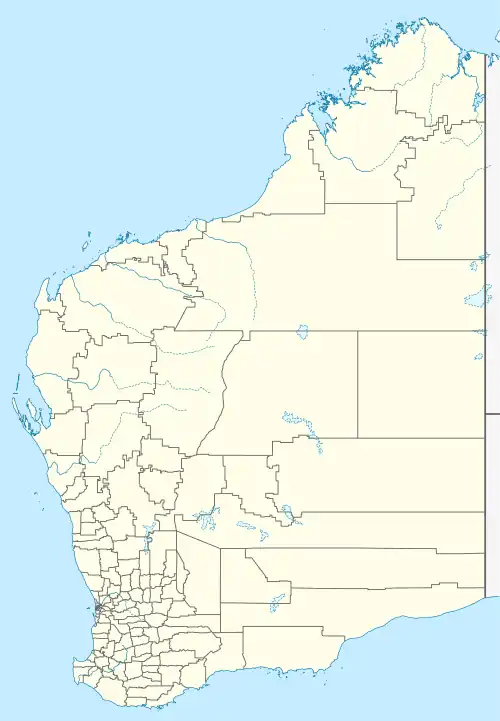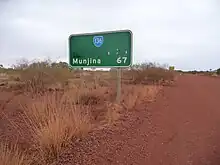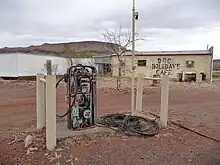Wittenoom, Western Australia
Wittenoom is a former town and a declared contaminated site, 1,420 kilometres (880 mi) north-north-east of Perth, in the Hamersley Range in the Pilbara region of Western Australia.[3][4] The declared contaminated site comprises 50,000 hectares (120,000 acres), making it the "largest contaminated site in the southern hemisphere".[5][6]
| Wittenoom Western Australia | |||||||||
|---|---|---|---|---|---|---|---|---|---|
 State government warning sign near the entrance to the former Wittenoom township. | |||||||||
 Wittenoom | |||||||||
| Coordinates | 22°14′23″S 118°20′05″E | ||||||||
| Population | 0 (SAL 2021)[1] | ||||||||
| Established | 1950[2] | ||||||||
| Gazetted | Degazetted June 2007 | ||||||||
| Postcode(s) | 6751 | ||||||||
| Area | 353.1 km2 (136.3 sq mi) | ||||||||
| Location | 140 km (87 mi) from Tom Price | ||||||||
| LGA(s) | Shire of Ashburton | ||||||||
| State electorate(s) | North West Central | ||||||||
| Federal division(s) | Durack | ||||||||
| |||||||||
The area around Wittenoom was mainly pastoral until the 1930s when mining for blue asbestos began. By 1939, major mining began in Yampire Gorge, which was closed in 1943 when mining began in Wittenoom Gorge. In 1947, a company town was built and, during the 1950s, it was the Pilbara's largest town. The peak population, as recorded by the Australian census conducted on 30 June 1961, was 881 (601 males and 280 females).[7] During the 1950s and early 1960s, Wittenoom was Australia's only supplier of blue asbestos. The mine was shut down in 1966 due to its unprofitability, and growing health concerns from asbestos mining in the area.
The former townsite no longer receives government services. In December 2006, the Government of Western Australia announced that the town's official status would be removed and, in June 2007, Jon Ford, the Minister for Regional Development, announced that the townsite had officially been degazetted. The town's name was removed from official maps and road signs, and the Shire of Ashburton is able to close roads that lead to contaminated areas.
The Wittenoom steering committee met in April 2013 to finalise closure of the town, limit access to the area, and raise awareness of the risks. Details of how that would be achieved were to be determined but it would probably necessitate removing the town's remaining residents, converting freehold land to crown land, demolishing houses, and closing or rerouting roads. By 2015, six residents remained. In 2017, the number had dropped to four,[8] to three in 2018, and to two in 2021.[9]
As of September 2022, Wittenoom had no remaining residents, and demolition of remaining structures by the Western Australian Government began in May 2023.[10]
Name
Wittenoom was named by Lang Hancock after Frank Wittenoom, his partner in the nearby Mulga Downs Station. The land around Wittenoom was originally settled by Wittenoom's brother, politician Sir Edward Horne Wittenoom.[2]
By the late 1940s, there were calls for a government townsite near the mine, and the Mines Department recommended it be named Wittenoom, advising that adoption of that name was strongly urged by the local people.
The name was approved in 1948, but it was not until 2 May 1950 that the townsite was officially gazetted.[11] In 1951, the name was changed to Wittenoom Gorge at the request of the mining company but, in 1974, it was changed back to Wittenoom.
The mine closed in 1966, and the official abolition of the town was gazetted in March 2007.[2]
History
In 1917, the Mines Department first recorded the presence of blue asbestos in the Hamersley Ranges. In the early 1930s, Lang Hancock discovered Wittenoom Gorge, on the Mulga Downs property.[13]
In 1937, Hancock showed samples of blue asbestos (crocidolite) that he had picked up in the Gorge to Islwyn Walters and Walter Leonard, who were mining and treating white asbestos at Nunyerrie, and at Lionel near Nullagine. When Hancock learned the fibre would fetch £70 per ton, he immediately pegged the best claims in Wittenoom Gorge.
Leo Snell, a kangaroo shooter on Mulga Downs, pegged a claim on Yampire Gorge, where there was a lot more blue asbestos. Walters and Leonard purchased Yampire Gorge from Snell, moved their treatment plant there, and began mining and treating the fibre. When Leonard cabled London that two miles (3.2 km) of asbestos in sight at Yampire Gorge, they cabled him back saying he should take a holiday. Leonard had to send a photograph before it was believed Yampire Gorge contained that much asbestos.
Walters and Leonard cleared the way into Yampire Gorge by blasting the biggest rocks and pulling them out of the way with a camel team. Even after that, it took them seven hours to drive their lorry the 24 kilometres (15 mi) from the workings to their treatment plant.
By 1940, twenty-two men were employed at the Yampire Gorge workings and about 375 tons were mined and transported by mule team wagons to the coast at Point Samson. During World War II, communications with England became difficult, and de Berrales acquired an interest in the mines.
In 1943, the Colonial Sugar Company, through its subsidiary, Australian Blue Asbestos Ltd., took over both the Wittenoom and Yampire Mines. Lang Hancock, who watched his station property transform to a town, stated in 1958: "Izzy Walters was the man who stuck it and produced the market that made Wittenoom of today possible." Walter's partner, Len Leonard, put it this way in 1958: "but for his (Islwyn Walters) sheer grit and hard work there would be no such thing as Wittenoom. We have him to thank for that."
Due to a lack of profitability however, the mine at Wittenoom was closed in 1966.
Closing of the town

As of 2016, Wittenoom had only three permanent residents[14] who defied the Government of Western Australia's announced intention to remove services, disconnect electric power, compulsorily acquire the remaining privately-owned properties and demolish the town.[15][16] There were still three residents in late 2018 and in September 2022, the last resident was evicted.[17][18][19]
In November 2006, a report by consultants GHD Group and Parsons Brinckerhoff evaluated the continuing risks associated with asbestos contamination in the town and surrounding areas, classing the danger to visitors as medium and to residents as extreme.[15][16] In December 2006, Minister for the Pilbara and Regional Development, Jon Ford, said that Wittenoom's status as a town would be removed and, in June 2007, he announced that the townsite status had been officially removed.[20]
Both the Department of Health and an accredited contaminated sites auditor reviewed the report, with the latter finding that the detected presence of free asbestos fibres in surface soils from sampled locations presented an unacceptable public health risk. The auditor recommended that the former townsite and other impacted areas defined in the report be classified as "Contaminated - Remediation Required". On 28 January 2008, the Department of Environment and Conservation classified Wittenoom as a contaminated site under the Contaminated Sites Act 2003.[15][16]
However, opinion is not unanimous on the danger posed. Mark Nevill, a geologist and former Labor MLC for the Mining and Pastoral district, said in an interview in 2004 that the asbestos levels in the town were below the detection level of most equipment, and the real danger was located in the gorge itself which contains the mine tailings.
Residents once operated a camping ground, guest house and gem shop for passing tourists. The roof of the gem shop is now caved in and the wood of the guest house is rotten, while the camping ground is nowhere to be found.[21][22]
It was reported in 2018 that thousands of travellers still visited the ghost town every year, as a form of extreme tourism.[23]
The Australian Mesothelioma Registry (AMR) is a national database that keeps track of information about people who have been diagnosed with mesothelioma after July 2010. It records all new cases in order to help the government develop policies about how to deal with asbestos that still remains in the country and reduce the incidence of mesothelioma in the future.[24]
The Wittenoom Closure Bill was reintroduced to the Western Australian Parliament in August 2021, and was passed on 24 March 2022.[25] The bill enabled the compulsory acquisition and demolition of the 14 remaining privately-owned properties in the former townsite.[26]
The traditional owners of country where Wittenoom is situated, the Panyjima people, have petitioned the Western Australian Parliament to not only remove all of Wittenoom's remaining buildings, but to remediate the land so that it is no longer contaminated.[9]
The Wittenoom Closure Bill was passed by the Western Australian Parliament in March 2022, allowing the government to permanently close Wittenoom by compulsorily acquiring the remaining private properties and remove all infrastructure from the town.[27][28] In September 2022, the last resident was evicted.[17][29] As of September 2022, the town was classified as deserted, and closed to the public. A bushfire reportedly hit the area around 26 December 2022, causing damage to remaining buildings and disrupting plans to demolish the site during the 2023 dry season.[30]
Legacy

The 1990 Midnight Oil song, "Blue Sky Mine" and the group's album, Blue Sky Mining, was inspired by the town and its mining industry,[31] as were He Fades Away and Blue Murder by Alistair Hulett. The town and its history are also featured in the novel Dirt Music by Tim Winton.
Digital poet Jason Nelson created the work Wittenoom: speculative shell and the cancerous breeze, an interactive exploration of the town's death. It won the Newcastle Poetry Prize in 2009.[32]
In the thriller novel The Dead Heart, by Douglas Kennedy, the plot involves an imaginary location called Wollanup,[33] which corresponds to Wittenoom. The Dead Heart was adapted as a comic by Kennedy and the illustrator Christian de Metter, under the title Dead Heart.
See also
References
- Australian Bureau of Statistics (28 June 2022). "Wittenoom (Suburb and Locality)". Australian Census 2021 QuickStats. Retrieved 28 June 2022.
- "History of country town names – W". Western Australian Land Information Authority. Archived from the original on 14 March 2022. Retrieved 10 September 2007.
- "Prohibited Areas – Wittenoom and Yampire Gorge" (PDF). Shire of Ashburton. 2019. Archived from the original (PDF) on 11 July 2020. Retrieved 16 July 2019.
- "Closure of former Wittenoom Townsite Roads". Shire of Ashburton (News). Western Australia. 9 May 2019. Retrieved 16 July 2019.
- Macmath, Antoine (11–13 November 2019). Keynote discussion: The Wittenoom legacy (PDF). Asbestos Safety 2019 Conference. Perth, Western Australia. pp. 4–16. Retrieved 22 September 2020.
- Foster, Ally (21 July 2019). "Tourists flock to 'Australia's Chernobyl' despite health risks". news.com.au. Surry Hills. Retrieved 26 September 2020.
- "PART V.-POPULATION AND DWELLINGS IN LOCALITIES" (PDF). Retrieved 1 October 2023.
- Croy, Liam (2 January 2017). "It may be a ghost town but for some Wittenoom is home". The West Australian. Perth. Retrieved 26 September 2020.
- Moussalli, Isabel; Tyndall, Andrew (11 November 2021). "Last homes in asbestos-riddled Wittenoom to be demolished, but some want to stay". ABC News. Australian Broadcasting Corporation. Retrieved 12 November 2021.
- "This town was taken off the map to deter thrillseekers. Now the last buildings are being demolished". ABC News. 8 May 2023.
- "Western Australian Government Gazette 42, 1950 Page 974" (PDF). State Law Publisher. Retrieved 15 November 2010.
- "Place No. 60 St Paul's Catholic Church Karratha" (PDF). City of Karratha. Shire of Roebourne. 2012. Archived from the original (PDF) on 8 March 2022. Retrieved 26 September 2020.
- Edmonds, Jack (25 July 1958). "North-West Pioneer lived in a packing Case". Daily News. Perth. ISSN 1839-8146.
- Garrick, Melanie; Florance, Loretta (18 November 2016). "Wittenoom: The survivors of an erased town". Australian Broadcasting Corporation. Retrieved 26 September 2020.
- Department of Environment and Conservation. "Search for Known Contaminated Sites". Archived from the original on 3 September 2017. Retrieved 14 November 2010.
- Snell, Beryl; Langley, Jeffrey (2009). The Wittenoom Disaster (PDF) (Report). West Perth: WorkSafe, Department of Commerce, Government of Western Australia. Archived from the original (PDF) on 15 September 2009. Retrieved 14 November 2010.
- Carr, Cameron; Tyndall, Andrew (12 September 2022). "Wittenoom's last resident evicted without compassion from WA Lands Minister, daughter says". ABC News. Retrieved 15 September 2022.
- Carr, Cameron (15 September 2022). "WA Lands Minister John Carey stands by eviction of last Wittenoom resident Lorraine Thomas". ABC News. Retrieved 15 September 2022.
- Michelmore, Karen (20 March 2019). "Wittenoom residents to be forced out as frustration boils over in effort to close deadly site". ABC News. Australian Broadcasting Corporation. Retrieved 13 February 2021.
- "New report into Wittenoom's asbestos risks". Regional Development Minister Jon Ford - Government of Western Australia. Archived from the original on 11 March 2012. Retrieved 14 November 2010.
- O'Donnell, Mick (6 December 2004). "Wittenoom's diehard residents stay put". The 7.30 Report. Archived from the original on 24 March 2017. Retrieved 15 February 2008.
- Fildes, Andrew (2006). "The Doom of Wittenoom". www.pbase.com. Retrieved 30 October 2020.
- De Poloni, Gian (12 July 2018). "Tourists warned over visiting asbestos-riddled Wittenoom, Australia's most dangerous ghost town". ABC News. Australian Broadcasting Corporation. Retrieved 30 October 2020.
- Sasser, Rachel (26 February 2017). "Asbestos Issues and Mesothelioma in Australia". mesowatch.com. Archived from the original on 11 July 2020. Retrieved 30 October 2020.
- Robinson, Tom; Gorman, Verity; Williams, Eddie (24 March 2022). "WA government bill to close asbestos-riddled town Wittenoom ends 'dark chapter' of state's history". ABC News. Australian Broadcasting Corporation. Retrieved 24 March 2022.
- Government of Western Australia (4 August 2021). "Final closure of Wittenoom nears as Bill returns to Parliament". mediastatements.wa.gov.au. Archived from the original on 12 November 2021. Retrieved 12 November 2021.
- Robinson, Tom; Gorman, Verity; Williams, Eddie (24 March 2022). "WA government bill to close asbestos-riddled town Wittenoom ends 'dark chapter' of state's history". ABC News. Retrieved 15 September 2022.
- "Wittenoom to be closed permanently with passing of bill through State Parliament". Media Statements. 24 March 2022. Retrieved 15 September 2022.
- Carr, Cameron (15 September 2022). "WA Lands Minister John Carey stands by eviction of last Wittenoom resident Lorraine Thomas". ABC News. Retrieved 15 September 2022.
- Robinson, TOM (8 January 2023). "Asbestos-littered town of Wittenoom on track for demolition after bushfire razes buildings". ABC News. Retrieved 9 January 2023.
- "Blue Sky Mine by Midnight Oil". Songfacts. 2020. Retrieved 30 October 2020.
- Nelson, Jason. "Curriculum Vitae" (PDF). Retrieved 30 October 2020.
- Kennedy, Douglas (1994). The Dead Heart. Brown Little. ISBN 0316909475. Retrieved 10 June 2021.
Bibliography
- Glossop, Laurie (11–13 November 2019). Wittenoom Geology and History (PDF). Asbestos Safety 2019 Conference. Perth, Western Australia. pp. 19–39. Retrieved 22 September 2020.
Further reading
- Hills, Ben (1989). Blue Murder: Two Thousand Doomed to Die: the Shocking Truth about Wittenoom's Deadly Dust. South Melbourne: Sun Books. ISBN 9780725105815.
External links
- Wittenoom: Asbestos contamination and management (Western Australian Government)
- The Asbestos Disease Society of Australia